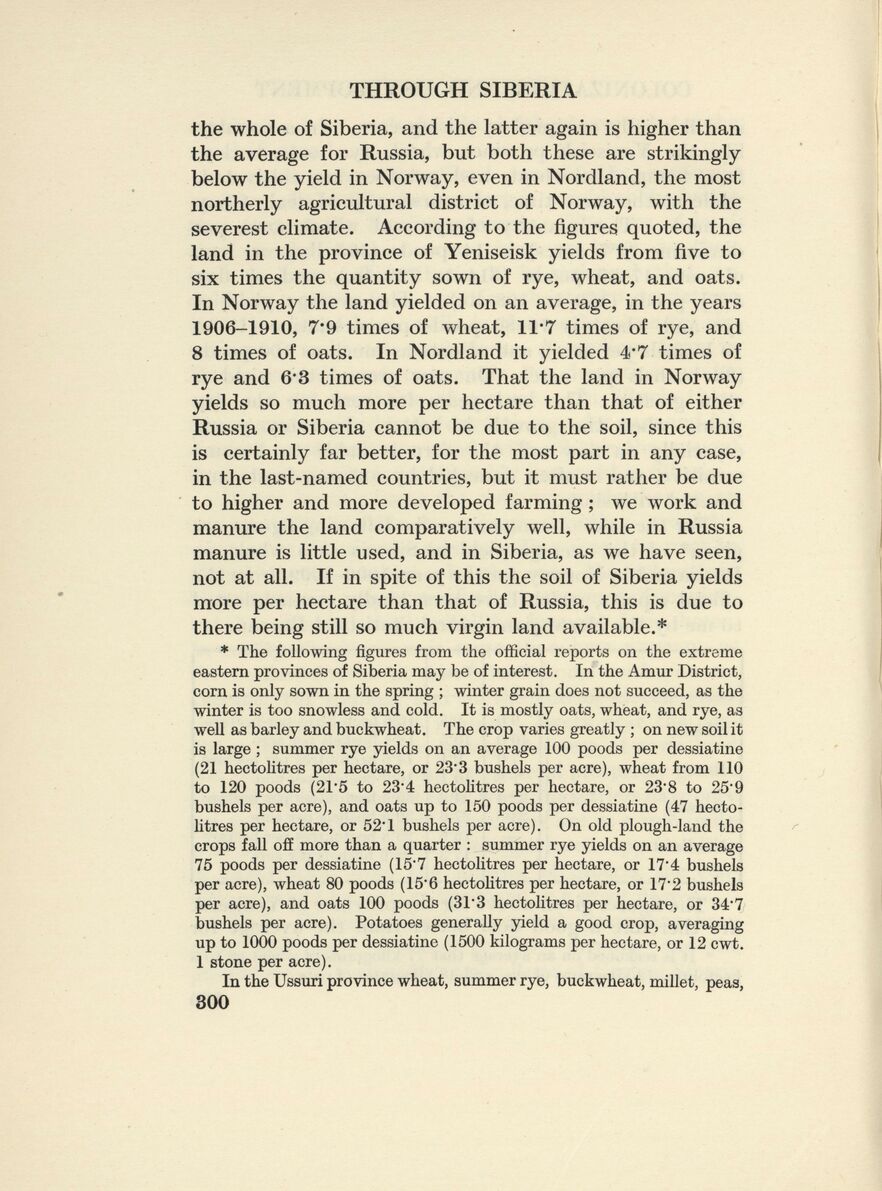
Full resolution (JPEG) - On this page / på denna sida - XIII. The colonization and development of Siberia

<< prev. page << föreg. sida << >> nästa sida >> next page >>
Below is the raw OCR text
from the above scanned image.
Do you see an error? Proofread the page now!
Här nedan syns maskintolkade texten från faksimilbilden ovan.
Ser du något fel? Korrekturläs sidan nu!
This page has never been proofread. / Denna sida har aldrig korrekturlästs.
THROUGH SIBERIA
the whole of Siberia, and the latter again is higher than
the average for Russia, but both these are strikingly
below the yield in Norway, even in Nordland, the most
northerly agricultural district of Norway, with the
severest climate. According to the figures quoted, the
land in the province of Yeniseisk yields from five to
six times the quantity sown of rye, wheat, and oats.
In Norway the land yielded on an average, in the years
1906-1910, 7*9 times of wheat, 11*7 times of rye, and
8 times of oats. In Nordland it yielded 4*7 times of
rye and 6*3 times of oats. That the land in Norway
yields so much more per hectare than that of either
Russia or Siberia cannot be due to the soil, since this
is certainly far better, for the most part in any case,
in the last-named countries, but it must rather be due
to higher and more developed farming ; we work and
manure the land comparatively well, while in Russia
manure is little used, and in Siberia, as we have seen,
not at all. If in spite of this the soil of Siberia yields
more per hectare than that of Russia, this is due to
there being still so much virgin land available.*
* The following figures from the official reports on the extreme
eastern provinces of Siberia may be of interest. In the Amur District,
corn is only sown in the spring ; winter grain does not succeed, as the
winter is too snowless and cold. It is mostly oats, wheat, and rye, as
well as barley and buckwheat. The crop varies greatly ; on new soil it
is large ; summer rye yields on an average 100 poods per dessiatine
(21 hectolitres per hectare, or 23*3 bushels per acre), wheat from 110
to 120 poods (21*5 to 234 hectolitres per hectare, or 23"8 to 25*9
bushels per acre), and oats up to 150 poods per dessiatine (47 hecto
litres per hectare, or 52’1 bushels per acre). On old plough-land the
crops fall off more than a quarter : summer rye yields on an average
75 poods per dessiatine (15*7 hectolitres per hectare, or 17’4 bushels
per acre), wheat 80 poods (15*6 hectolitres per hectare, or 17*2 bushels
per acre), and oats 100 poods (31’3 hectolitres per hectare, or 34-7
bushels per acre). Potatoes generally yield a good crop, averaging
up to 1000 poods per dessiatine (1500 kilograms per hectare, or 12 cwt.
1 stone per acre).
In the Ussuri province wheat, summer rye, buckwheat, millet, peas,
300
<< prev. page << föreg. sida << >> nästa sida >> next page >>